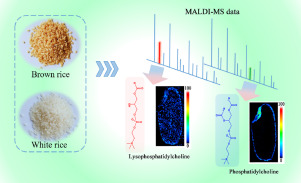Abstract
Phospholipids are one of the main nutrients in rice, which have a positive effect on cancer, coronary heart disease and inflammation. However, phospholipids will become small molecular volatile substances during the aging process of rice, resulting in change the flavor of rice. Therefore, mapping the concen-tration and the spatial distribution of phospholipids in rice are of tremendous significance in its function research. In this work, we established a matrix-assisted laser desorption/ionization time-of-flight mass spectrometry (MALDI-TOF-MS) imaging method for the spatial distribution analysis of phospholipids in rice. A total of 12 phospholipid compounds were found in the range of m/z 50 0-10 0 0 through a se-ries of conditions optimization. According to the results, lysophosphatidylcholine (LPC) species spread throughout the rice tissue sections and phosphatidylcholine (PC) species distributed in the bran and em-bryo (particularly in the scutellum). We also compared the signal intensities of phospholipids in different parts of white rice and brown rice by region of interest (ROI) analysis, which showed the relative con-tent of PC species was higher in the embryo and gradually decreased until disappeared with the increase of processing degree during the processing of brown rice to white rice. The PC species on the surface of rice could be used as an important indicator to identify the processing degree of rice. Our work not only establish a MALDI-TOF-MS imaging method for spatial distribution analysis of rice, but also provide the necessary reference for ensuring food security, improving the eating quality of rice and the health benefits of consumers.

KeyWords Plus:ORYZA-SATIVA L.; STORAGE; LIQUID; LIPIDS; CHROMATOGRAPHY; QUALITY; BROWN
Published in JOURNAL OF CHROMATOGRAPHY A,Volume: 1651;10.1016/j.chroma.2021.462302,AUG 16 2021


